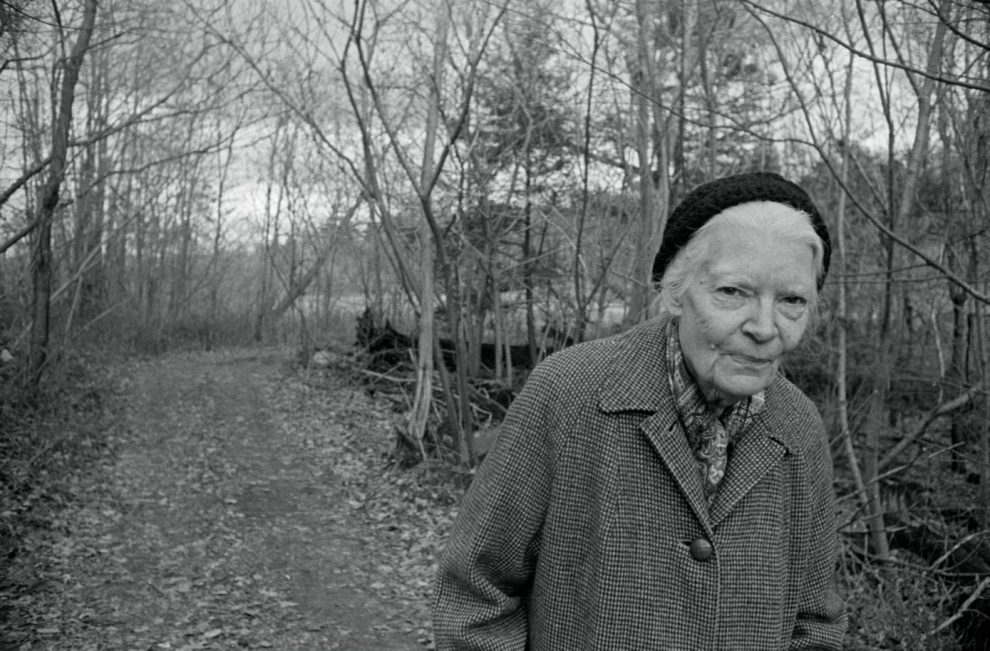Can you think of a word that describes a person who devoted much of her life to being with people many of us cross the street to avoid?
Who for half a century did her best to make sure they didn’t go hungry or freeze on winter nights?
Who went to Mass every day until her legs couldn’t take her that far, at which point Communion was brought to her?
Who prayed every day for friend and enemy alike, and whose prayers, some are convinced, had miraculous results?
Who went to Confession every week?
Who was devoted to the rosary?
Who wore hand-me-downs and lived in cold-water flats?
Whose main goal in life was to follow Christ and to see him in the people around her?
A saint.
Can you think of a word that describes a person who refused to pay taxes, didn’t salute the flag, never voted, and went to prison every now and then for protests against war and social injustice?
Who spoke in a plain and often rude way about our way of life?
Who complained that the church wasn’t paying enough attention to its own teachings and compared some of its bishops to sharks?
A troublemaker.
Dorothy Day, saint and troublemaker.
Mostly, saints lived in the distant past, that is before we were born, and have been presented to us with all blemishes removed.
The record of who Dorothy Day was, what she was like, and what she did is too complete and accessible for her to be hidden in wedding-cake icing. She will be the patron saint not only of homeless people and those who try to care for them but also of people who lose their tempers.
Dorothy was not without rough edges.
To someone who told her she was too hotheaded, she replied, “I hold more temper in one minute than you will hold in your entire life.” To a college student who asked a sarcastic question about her recipe for soup, she responded, “You cut the vegetables until your fingers bleed.” To a journalist who told her it was the first time he had interviewed a saint, she replied, “Don’t call me a saint—I don’t want to be dismissed that easily.”
When we met
I was 20 years old the first time I saw her. She was ancient, that is to say 62 years old—seven years older than I am today. This means for 35 years she has been scolding and encouraging me on a daily basis. The mere fact of her having died 17 years ago doesn’t seem to get in the way.
I met her at the Catholic Worker Farm on Staten Island in the days when the island still had rural areas, its only link to the rest of New York City being the ferry. She was sitting with several other people at the battered table where the community had its meals. Before her was a pot of tea, a few cups, and a pile of letters.
The Catholic Worker received a good deal of mail every day, much of it for Dorothy. She often read the letters aloud, telling a story or two about the people who had written them.
This was the Dorothy Day University in full swing, although I didn’t know it at the time. A good part of Dorothy’s life was spent reading and writing letters; even her monthly columns were usually nothing more than long letters. She will be one of the patron saints of letter writers.
People sometimes think of her as the personification of the simple life, but in reality her days tended to be busy, complicated, and stressful. Often she was away traveling—visiting other Catholic Worker communities, speaking at colleges, seminaries, local parishes, getting around by bus or a used car on its last spark plugs.
It was an unforgettable experience hearing her before an audience. She had a direct, unpremeditated, story-centered way of speaking—no notes, no rhetorical polish, a manner that communicated a certain shyness but at the same time wisdom, conviction, faith, and courage. She wasn’t the kind of speaker who makes those she is addressing feel stupid or without possibilities.
Her basic message was stunningly simple: We are called by God to love one another as he loves us. (These days many of us go to great lengths to avoid saying he in such a sentence, but Dorothy steadily resisted a gender-neutral vocabulary.)
If God was one key word, hospitality was another. She repeated a saying from the early church, “Every home should have a Christ room in it so that hospitality may be practiced.”
Hospitality, she explained, is simply practicing God’s mercy with those around us. Christ is in the stranger, in the person who has nowhere to go and no one to welcome him.
“Those who cannot see the face of Christ in the poor are atheists indeed,” she often said. Hardly a day passed when she didn’t speak about the works of mercy.
The works of mercy—feeding the hungry, giving drink to the thirsty, clothing the naked, giving shelter to the homeless, caring for the sick, visiting prisoners, burying the dead—had to be understood not only in a material but also a spiritual way: There is hunger not only for food but also for faith, not only for a place at the table but also for a real welcome, not only for assistance but also for listening, not only for kind words but also for truth. There is not only hospitality of the door but also hospitality of the face.
For all her traveling, most of Dorothy’s life was spent in New York City. Before her conversion in 1924 when she was 28 years old, she bought a small beach house on Staten Island, which remained part of her life until she was too weak to make the trip anymore. It was a simple structure with a few plain rooms and a cast-iron stove.
Walking on the beach or to the post office, rosary in hand, she prayed her way through an out-of-wedlock pregnancy, prayed her way through the Baltimore Catechism, prayed her way to her daughter Tamar’s baptism in a nearby Catholic parish, prayed her way through the collapse of a common-law marriage and to her own baptism, and prayed her way through the incomprehension of her atheist friends who regarded all religion as snake oil. Years later it was mainly in the beach house that she found the peace and quiet to write her autobiography, The Long Loneliness (Harper San Francisco, 1981).
Life in the big city
The main part of her New York life was in Manhattan with the urban part of the Catholic Worker community. In the early ’60s, St. Joseph’s House of Hospitality was on Chrystie Street—a decrepit three-story building a block from the Bowery, in those days the city’s grimmest avenue.
As there wasn’t enough room inside, the down-and-out were often lined up at the door waiting either for food or clothing—men mainly, people often grouped under the heading “bums.”
And bums had been a major part of Dorothy’s life since leaving college in Illinois to come to New York. She rented a room on the Lower East Side and, at age 18, became a reporter for New York’s socialist daily newspaper, The Call.
Dorothy’s office at the Catholic Worker was hardly big enough for her desk. Here she and I would sometimes discuss—occasionally argue—what should be in the next issue of the paper.
It wasn’t the easiest place for conversation. The ground floor was where food was prepared and meals served, each meal in shifts as there were only a few bench-style tables. From morning till night, it tended to be noisy.
Sitting at her desk one afternoon, talking about the next issue, we could hardly hear each other. Dorothy got up, opened her office door, and yelled, “Holy silence!” For a few minutes it was almost quiet.
On the second floor, site of the two clothing rooms, one for men, one for women, there was an area used for daily prayer as well as recitation of the rosary every afternoon. None of this was obligatory, but part of the community was always present, the community being a mixture of “staff” (as those of us who came as volunteers were called) and “family” (people who had once come in for clothing or a bowl of soup and gradually became part of the household).
It wasn’t a comfortable life. At the time I joined, Dorothy had a sixth-floor walk-up apartment in a tenement on Spring Street. For $25 a month she got two small rooms, a bathtub next to the kitchen sink, and a bathroom the size of a broom closet.
This may sound uninviting, but Dorothy regarded the neighborhood as luxury enough. With an Italian bakery across the street, there was always the intoxicating perfume of Italian cooking in the air. When the San Gennaro Festival was celebrated annually just around the corner for a week, that part of Manhattan became a village in sight of Naples.
The day finally came when climbing those five flights of stairs became too much for her aging knees, so we moved her to a similar apartment only one flight up on Ridge Street—also $25 a month, but in a seedier neighborhood.
The place was in appalling condition. Stuart Sandberg and I went down to clean and paint the two rooms, dragging box after box of old linoleum and other debris down to the street, including what seemed to us a hideous painting of the Holy Family—Mary, Joseph, and Jesus rendered in a few bright colors against a battleship gray background on a piece of plywood. We shook our heads, deposited it in the trash along the curb, and went back to work.
Later Dorothy arrived carrying the painting. “Look what I found! The Holy Family! It’s a providential sign, a blessing.” She put it on the mantle of the apartment’s bricked-up fireplace. Dorothy had a gift for finding beauty where others tended to see rubbish.
The discipline of prayings
If she was one of the freest persons alive, she was also one of the most disciplined. This was most notable in her religious life. Whether traveling or home, it was a rare day when Dorothy didn’t go to Mass, while on Saturday evenings she went to Confession. Sacramental life was the bedrock of her existence.
She never obliged anyone to follow her example, but God knows she gave an example. When I think of her, the first image that comes to mind is Dorothy on her knees praying before the Blessed Sacrament either in the chapel, at the farm, or in one of several urban parish churches near the Catholic Worker. One day, looking into the Bible and Missal she had left behind when summoned for a phone call, I found long lists of people, living and dead, whom she prayed for daily.
Occasionally she spoke of her “prayings”: “We feed the hungry, yes. We try to shelter the homeless and give them clothes, but there is strong faith at work; we pray. If an outsider who comes to visit us doesn’t pay attention to our prayings and what that means, then he’ll miss the whole point.”
She was attentive to fast days and fast seasons. It was in that connection she told me a story about prayer. For many years, she said, she had been a heavy smoker. Her day began with lighting up a cigarette. Her big sacrifice every Lent was giving up smoking, but having to get by without a cigarette made her increasingly irritable as the days passed, until the rest of the Catholic Worker staff was praying she would light up a smoke.
One year, as Lent approached, the priest who ordinarily heard her confession urged her not to give up cigarettes that year but instead to pray daily, “Dear God, help me stop smoking.”
She used that prayer for several years without it having any impact on her addiction. Then one morning she woke up, reached for a cigarette, and realized she didn’t want it—and never smoked another.
People sometimes tell me how lucky I am to have been part of the same community that Dorothy Day belonged to. They picture a group of more or less saintly people having a wonderful time doing good works. In reality, Catholic Worker community life in Manhattan in the early ’60s had much in common with purgatory.
The staff was made up of people with very different backgrounds, interests, temperaments, and convictions. We ranged from the gregarious to the permanently furious.
There was a recluse named Keith living in a back room on the third floor who maintained the newspaper’s mailing list—a big job, as The Catholic Worker had nearly 100,000 subscribers. He was rarely seen and never said a word; communication with him was by notes. Another member of staff was the angry daughter of a millionaire newspaper publisher; the last I heard, she had become a leader of a Marxist sect.
But not everyone was all thorns. There was lean, gentle, long-suffering Charlie Butterworth, a lawyer who had graduated from Harvard but whose pacifism had led him to the Catholic Worker.
Arthur J. Lacey, with his matchstick body, was chiefly responsible for the men’s clothing room; he called himself “Haberdasher to the Bowery.” There was the always-teasing Stanley Vishnewski, who said most of us belonged “not to the Catholic Worker movement but to the Catholic Shirker movement.”
Agreement within the staff was as rare as visits by the president of the United States. The most bitter dispute I experienced had to do with how best to use the small amounts of eggs, butter, and other treats, which sometimes were given to us—use them for “the line” (people we often didn’t know by name who lined up for meals) or the “family,” as had been the custom. Though we worked side by side, saw each other daily, and prayed together, staff tension became too acute for staff meetings.
When Dorothy returned from a cross-country speaking trip, she told the two people running the kitchen that the butter and eggs should go to the family. This led to their resigning from kitchen work, and soon after they left the community trailing black smoke, convinced that Dorothy Day wasn’t living up to the writings of Dorothy Day.
One of the miracles of Dorothy’s life is that she remained part of a conflict-torn community for nearly half a century. Still more remarkable, she remained a person of hope and gratitude to the end. (She occasionally spoke of “the duty of hope.”)
Radical without party line
Dorothy was and remains a controversial person.There was hardly anything she did that didn’t attract criticism.
Even hospitality scandalizes some people. We were blamed for making people worse, not better, because we were doing nothing to “reform them.” A social worker once asked Dorothy how long the down-and-out were permitted to stay.
“We let them stay forever,” Dorothy answered. “They live with us, they die with us, and we give them a Christian burial. We pray for them after they are dead. Once they are taken in, they become members of the family. Or rather they always were members of the family. They are our brothers and sisters in Christ.”
What got her in the most hot water was her sharp social criticism. She pointed out that patriotism was a more powerful force in most people’s lives than the gospel. While she hated every kind of tyranny and never ceased to be thankful for America’s having taken in so many people fleeing poverty and repression, she was fierce in her criticism of capitalism and consumerism.
She said America had a tendency to treat people like Kleenex—use them and throw them away. “Our problems stem,” she said, “from our acceptance of this filthy, rotten system.”
She had no kind words for war or anything having to do with it—war was simply murder wrapped in flags. She was convinced Jesus had disarmed all his followers when he said to Peter, “Put away your sword, for whoever lives by the sword will perish by the sword.”
A way of life based on love, including love of enemies, left no room for killing. You couldn’t practice the works of mercy with one hand and the works of vengeance with the other.
No stranger to prison, she was first locked up as a young woman protesting with suffragettes in front of the White House during World War I and was last jailed in her 70s for picketing with farm workers.
She took pride in the young men of the Catholic Worker who went to prison rather than be drafted—“a good way to visit the prisoner,” she pointed out. Yet she also welcomed back others who had left Catholic Worker communities to fight in the Second World War. They might disagree about the best way to fight Nazism, but, as she often said, “there is no party line in the Catholic Worker movement.”
Dorothy was sometimes criticized for being too devout a Catholic. How could she be so radical about social matters and so conservative about her church? While she occasionally deplored statements or actions by members of the hierarchy, she was by no means an opponent of the bishops or someone campaigning for structural changes in the church.
What was needed, she said, wasn’t new doctrine but our living the existing doctrine. True, some pastors seemed barely Christian, but one had to aim for their conversion, an event that would not be hastened by berating them but rather by helping them see what their vocation requires. The way to do that was to set an example.
Pleased as she was when home Masses were allowed and the liturgy translated into English, she didn’t take kindly to smudging the border between the sacred and mundane. When a radical priest used a coffee cup for a chalice at a Mass celebrated in the soup kitchen on First Street, she afterward took the cup, kissed it, and buried it in the backyard. It was no longer suited for coffee—it had held the Blood of Christ. I learned more about the Eucharist that day than I had from any book or sermon.
I’m sometimes told, “Dorothy Day gives a fine example for people who don’t have a family to take care of and a mortgage to pay, but what about the rest of us?”
The rest of us includes my wife and me. I don’t have enough fingers on one hand to count our children, and the first of the month is mortgage-payment day.
But every time I open the door to guests, it’s partly thanks to Dorothy Day. Every time I think about things in the bright light of the gospel rather than in the gray light of money or the dim light of politics, her example has had its influence.
Every time I try to overcome meanness or selfishness rising up in myself, it is partly thanks to the example of Dorothy Day. Every time I defeat the impulse to buy something I can get along without, Dorothy Day’s example of voluntary poverty has had renewed impact. Every time I try to see Christ’s presence in the face of a stranger, there again I owe a debt to Dorothy Day.
No one else has made me think so much about the words we will hear at the Last Judgement: “What you did to the least person, you did to me.”
What I know of Christ, the church, sacramental life, the Bible, and truth-telling, I know in large measure thanks to her, while whatever I have done that was cowardly, opportunistic, or cruel is despite her. She has even shaped my reading life—the novels of Dostoyevsky, for starters.
It isn’t that Dorothy is the point of reference. Christ is. But I can’t think of anyone I’ve known whose Christ-centered life helped to make me a more Christ-centered person.
Over a century after she was born and decades after she died, Dorothy Day continues to touch our lives, not only as a person we remember with gratitude, but also as a saint—if by the word saint we mean a person who helps us see, by both precept and example, what it means to follow Christ.
“If I have accomplished anything in my life,” she said late in her life, “it is because I wasn’t embarrassed to talk about God.”
This article originally appeared in the November 1997 issue of U.S. Catholic.
Image: Bob Fitch photography archive, © Stanford University Libraries














Add comment